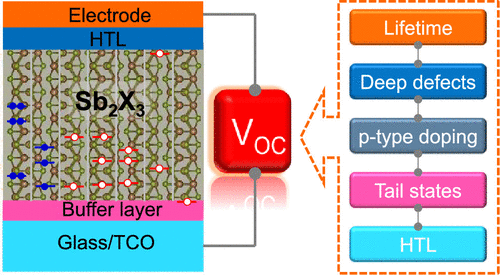当前位置:
X-MOL 学术
›
ACS Energy Lett.
›
论文详情
Our official English website, www.x-mol.net, welcomes your
feedback! (Note: you will need to create a separate account there.)
Open-Circuit Voltage Loss of Antimony Chalcogenide Solar Cells: Status, Origin, and Possible Solutions
ACS Energy Letters ( IF 19.3 ) Pub Date : 2020-06-04 , DOI: 10.1021/acsenergylett.0c00940 Chao Chen 1 , Jiang Tang 1
ACS Energy Letters ( IF 19.3 ) Pub Date : 2020-06-04 , DOI: 10.1021/acsenergylett.0c00940 Chao Chen 1 , Jiang Tang 1
Affiliation

|
Recently, antimony chalcogenide solar cells including Sb2S3, Sb2Se3, and Sb2(S,Se)3 have obtained considerable progress, with efficiency up to 7.5%, 9.2%, and 7.82%, respectively, and the efficiency values are largely plagued by a severe open-circuit voltage deficit. In this Perspective, we conduct a detailed analysis of open-circuit voltage loss in antimony chalcogenide solar cells with respect to the basic material properties (including carrier lifetime, defects, carrier density, and band tail states) and device properties (including recombination mechanism, hole transport layer, and device structure). We also note the main challenges at present and discuss future development directions. In the end, we provide some suggestions to overcome these challenges. We hope our work can promote the development of antimony-chalcogenide-based photoelectric devices, including solar cells, photodiodes, and photoelectrochemical cells.
中文翻译:

锑硫族化物太阳能电池的开路电压损失:状态,起源和可能的解决方案
最近,锑硫属化物太阳能电池包括Sb 2 S 3,Sb 2 Se 3和Sb 2(S,Se)3效率已分别达到7.5%,9.2%和7.82%的显着进步,效率值在很大程度上受到严重的开路电压不足困扰。在本“观点”中,我们针对基本材料特性(包括载流子寿命,缺陷,载流子密度和能带尾态)和器件特性(包括复合机理,包括硫族硫化物太阳能电池)的开路电压损耗进行了详细分析。空穴传输层和器件结构)。我们也注意到当前的主要挑战并讨论未来的发展方向。最后,我们提供了克服这些挑战的一些建议。我们希望我们的工作能够促进基于锑硫族化物的光电器件的开发,包括太阳能电池,光电二极管和光电化学电池。
更新日期:2020-07-10
中文翻译:

锑硫族化物太阳能电池的开路电压损失:状态,起源和可能的解决方案
最近,锑硫属化物太阳能电池包括Sb 2 S 3,Sb 2 Se 3和Sb 2(S,Se)3效率已分别达到7.5%,9.2%和7.82%的显着进步,效率值在很大程度上受到严重的开路电压不足困扰。在本“观点”中,我们针对基本材料特性(包括载流子寿命,缺陷,载流子密度和能带尾态)和器件特性(包括复合机理,包括硫族硫化物太阳能电池)的开路电压损耗进行了详细分析。空穴传输层和器件结构)。我们也注意到当前的主要挑战并讨论未来的发展方向。最后,我们提供了克服这些挑战的一些建议。我们希望我们的工作能够促进基于锑硫族化物的光电器件的开发,包括太阳能电池,光电二极管和光电化学电池。









































 京公网安备 11010802027423号
京公网安备 11010802027423号